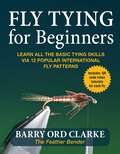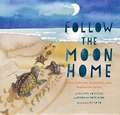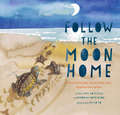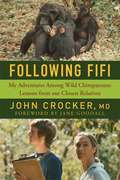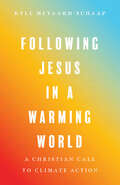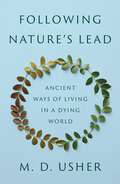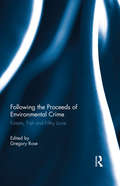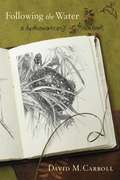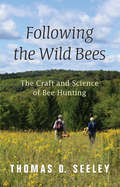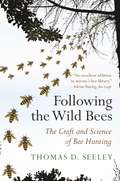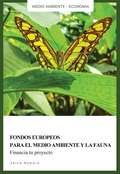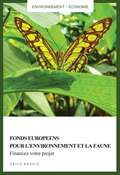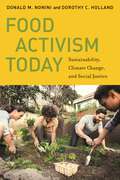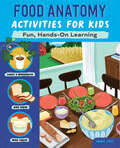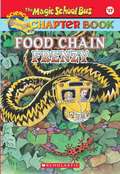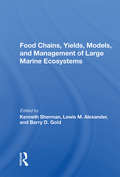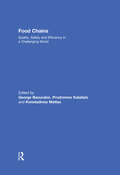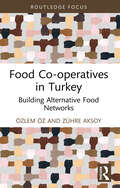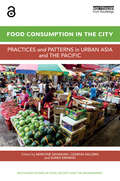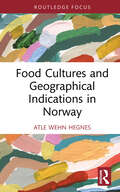- Table View
- List View
Flytying for Beginners: Learn All the Basic Tying Skills via 12 Popular International Patterns
by Barry Ord ClarkeThis is a guide book for those totally new to the art of tying flies. Until now, learning flytying from a book has not only been challenging, but often the cause of great frustration, with photographs or diagrams making even the elementary techniques difficult to grasp. Step-by-step images help a reasonably proficient flytyer understand the stages in making a fly, but for the new beginner, there will always be a gap between each step-by-step image, which can be bewildering. Seeing the manual maneuvers that take place in these pages can make the different between success and failure for a beginner. The techniques you will learn in this book are the building blocks for which all successful fishing flies, even the most complex ones, are based.
Folklore of American Weather
by Eric SloaneIn preparing this unusual book of American weather sayings and beliefs, Eric Sloane has made a painstaking effort to separate the true from the false, investigating origins and separating the many truly valuable pieces of weather lore from superstition, or what he calls "jackass jingles." As Mr. Sloane makes clear, folklore can be a very loose term used to cover a lack of knowledge of the very thing that folklore means: many things are passed off as folklore that are plain mistakes or inventions. Following general introductory remarks, Mr. Sloane has arranged his findings in an alphabetical folklore dictionary, enabling the reader to find readily the signs involving stars, wind, dew, rain, or whatever else he wishes. After each entry is a symbol indicating whether it is true (T), false (F), or possible (P). Thirty-five drawings by the author clarify and enhance the text of this entertaining and informative new book by America's favorite weather expert.
Follow the Line Around the World
by Laura LjungkvistFollow the line from the camels of the Sahara Desert to the blue whales of Greenland, from the giraffes of Kenya?s grasslands to the kangaroos of Australia?s Outback. This new Follow the Line book?illustrated in Laura Ljungkvist?s signature line style?takes young children around the world to see animals in their natural habitats. With informative facts and a gentle environmental message, Follow the Line Around the World is sure to appeal to those interested in taking better care of the earth.
Follow the Moon Home: A Tale of One Idea, Twenty Kids, and a Hundred Sea Turtles
by Deborah Hopkinson Philippe Cousteau<P>Acclaimed activist Philippe Cousteau and renowned author Deborah Hopkinson team up to offer a story of the powerful difference young people can make in the world. <P>Meet Viv, who has a new home and a new school by the sea, and follow her as she finds her way in a new place and helps bring together a whole community to save the sea turtles of the South Carolina coast.
Follow the Moon Home: A Tale of One Idea, Twenty Kids, and a Hundred Sea Turtles
by Deborah Hopkinson Philippe CousteauAcclaimed activist Philippe Cousteau and renowned author Deborah Hopkinson team up to offer a story of the powerful difference young people can make in the world. Meet Viv, who has a new home and a new school by the sea, and follow her as she finds her way in a new place and helps bring together a whole community to save the sea turtles of the South Carolina coast. Plus, this is the fixed format version, which looks almost identical to the print edition.
Following Fifi: My Adventures Among Wild Chimpanzees: Lessons From Our Closest Relatives
by Jane Goodall John CrockerAn exhilarating quest into a remote African forest to examine chimpanzees and understand the roots of human behavior. As a young student, John Crocker embarked on the adventure of a lifetime, spending eight months in the Gombe forest working with Jane Goodall. He followed families of wild chimpanzees from sunrise to sunset and learned the fundamental behavioral traits of these chimps as they raised their offspring. One chimpanzee captivated him. Her name was Fifi, and she displayed extraordinary patience and reassurance toward her infant, Freud. Upon returning home and becoming a doctor, Crocker found himself incorporating the lessons he learned from Fifi into his work as a father and physician. When he witnessed his young patients rocketing around his exam room, he would picture Fifi’s patience and tacit approval of Freud’s uninhibited and joyful exploration. Crocker shares how his time spent with our closest animal cousins has helped him better understand his patients with ADD, anxiety, and depression, and how primate traits hardwired into our own natural behavior help chimpanzees protect their community, raise their young, and survive. Finally, chronicling his return to Gombe thirty-six years later with his own son, he reflects on how his experience with the chimps has come full circle. An illuminating book that will raise thought-provoking questions about the evolution of human behavior and the importance of patience and strong family bonds, Following Fifi provides a greater understanding of what it means to be human.
Following Jesus in a Warming World: A Christian Call to Climate Action
by Kyle Meyaard-SchaapHave you ever looked at the effects of climate change and the apathy of so many around you and wondered, "What are we missing here?" Climate activist Kyle Meyaard-Schaap understands this feeling from personal experience. But in his years of speaking to and equipping Christians to work for climate action, he's seen the trend begin to shift. More and more young Christians are waking up to the realities of climate change. They want to help, but they're not sure how. Through stories from the field, theological and scriptural exploration, and practical advice, Meyaard-Schaap offers hope to Christians paralyzed by the scale of the crisis, helping us turn our paralysis into meaningful action. Following Jesus in a Warming World is a field guide for Christian climate action—one grounded not in a sense of guilt or drudgery, but in the joy of caring for creation.
Following Nature’s Lead: Ancient Ways of Living in a Dying World
by M. D. UsherIn the spirit of E. F. Schumacher&’s Small Is Beautiful, a dazzling and revelatory exploration of what ancient ideas and ways of living can teach us about creating a more sustainable worldHow should we think and live in a world facing environmental catastrophe? In this urgent, original, and wide-ranging book, classicist and farmer M. D. Usher brings together ancient, indigenous, and modern ideas about how to live in this world and describes how we might begin to reconnect with Nature and heal our damaged planet and lives. The ancients hewed close to Nature, the source of their survival, in ways that most of us can scarcely conceive of today, and ancient philosophy often argues that humans should follow Nature&’s lead. Usher makes the case that Nature&’s resilience can serve as a model for our own responses to climate trauma and all the other harms caused by modern lifestyles.Drawing on philosophy, science, economics, art, literature, history, and religion, Following Nature&’s Lead is both an indictment of human overreach and a celebration of human ingenuity and the adaptability of Nature. Here, Plato meets German biologist Jakob von Uexküll, Lucretius illuminates King Lear, and Diogenes the Cynic crosses swords with Henry Thoreau.Filled with vital and inspiring insights, Following Nature&’s Lead shows how the ancients can help teach us to live in accordance with Nature—and why it&’s essential for human survival that we learn to do so without delay.
Following the Last Wild Wolves
by Ian Mcallister Paul C. Paquet Chris DarimontThis book describes Ian McAllister's experiences over that period following two packs of wolves, one that dominates the extreme outer coastal islands, and another that lives farther inland in the heart of the temperate rainforest.McAllister, along with Chris Darimont and Paul C. Paquet, were the first to document the unique behavior of these animals in The Last Wild Wolves. In Following the Last Wild Wolves, McAllister brings readers up to date describing what has happened to the wolves and their environment since the book first appeared. He chronicles their unique behavior as they fish for salmon in the fall, target seals hauled out on rocks in winter, and give birth to their young in spring. He also describes the work of scientists with the Raincoast Conservation Society who have been studying the wolves and explains how their science corroborates his own observations and the traditional knowledge of the area's Native people. Most interestingly, the results of these studies reveal a genetically distinct population of wolves independent of and separate from all other known wolf populations on the planet.
Following the Proceeds of Environmental Crime: Fish, Forests and Filthy Lucre
by Gregory RoseHuge quantities of natural resources are illegally harvested and their proceeds laundered in the Asia-Pacific region, fostering corruption and undermining environmental governance. Most illegal exploitation and pollution occurs in countries with poor governance capacities, but much of the sale for profit and money laundering occurs in mature markets with well-developed governance capacities. Their asymmetrical enforcement capacities can complement each other. This book explores ways to combat illegal fishing and logging in Asia-Pacific region by the use of cooperative legal measures, particularly anti-money laundering and confiscation of proceeds techniques. Contributors to this volume cover themes including: the nature of transnational environmental crime; patterns in laundering of illicit fish and forest products; networks for distribution of illicit products; weaknesses in current systems for assurance of the legality of products; and international legal cooperation to enforce anti-money laundering laws in relation to illicit products. In considering these topics the book explores how the innovative use of anti-money laundering measures and the seizure of criminal proceeds can as policy options to combat transnational fishery and forestry crimes. The book will be of keen interest to scholars and students of environmental law and criminal law, and excellent use for practitioners in natural resources conservation law.
Following the Water: A Hydromancer's Notebook
by David M. CarrollThe writer, naturalist, and artist David Carroll illuminates the ecology and life histories the tree frogs, hawks, foxes, and the increasingly rare wood and spotted turtles he has been tracking for decades with the precision and passion that won him a 2006 MacArthur "genius" award.Following theWater is the intensely observed chronicle of Carroll's annual March-to-November wetlands immersion-from the joy of the first turtle sighting in March to the gorgeously described, vibrant trilling of tree frogs ("lichen with eyes") in late May to the ancient sense of love and loss Carroll experiences each autumn when it is time once again to part with open water.Illustrated with the author's fine pen-and-ink drawings, Following theWater is a gorgeous evocation of nature, an utterly unique "admission ticket to a secret corner of the world" (Bill McKibben).
Following the Wild Bees: The Craft and Science of Bee Hunting
by Thomas D. SeeleyFollowing the Wild Bees is a delightful foray into the pastime of bee hunting, an exhilarating outdoor activity that used to be practiced widely but which few people know about today. Thomas Seeley, a world authority on honey bees, vividly describes the history and science behind this lost pastime and how anyone can do it. Following the Wild Bees is both a unique meditation on the pleasures of the natural world and a guide to the ingenious methods that compose the craft of the bee hunter.Seeley explains how one finds a patch of flowers humming with honey bees, captures and sumptuously feeds the bees, and then releases and follows them, step-by-step in whatever direction they fly, back to their secret residence in a hollow tree, old building, or abandoned hive. The bee hunter's reward is a thrilling encounter with nature that challenges mind and body while also giving new insights into the remarkable behavior of honey bees living in the wild.Drawing on decades of experience as a bee hunter and bee biologist, Seeley weaves informative discussions of the biology of wild honey bees with colorful historical anecdotes, personal insights, and beautiful photos. Whether you're a bee enthusiast or just curious about the natural world, Following the Wild Bees is the ideal companion for newcomers to bee hunting and a rare treat for armchair naturalists.
Following the Wild Bees: The Craft and Science of Bee Hunting
by Thomas D. SeeleyA how-to book on an exhilarating outdoor activity and a unique meditation on the pleasures of the natural worldFollowing the Wild Bees is a delightful foray into the pastime of bee hunting, an exhilarating outdoor activity that used to be practiced widely but which few people know about today. Weaving informative discussions of bee biology with colorful anecdotes, personal insights, and beautiful photos, Thomas Seeley describes the history and science behind this lost pastime and how anyone can do it. The bee hunter’s reward is a thrilling encounter with nature that challenges mind and body while also giving insights into the remarkable behavior of honey bees living in the wild. Whether you’re a bee enthusiast or just curious about the natural world, this book is the ideal companion for newcomers to bee hunting and a rare treat for armchair naturalists.
Fondos europeos para el medio ambiente y la fauna: Financia tu proyecto
by Erica RoggioLa Unión Europea es uno de los principales donantes a nivel mundial. La gestión de los recursos naturales, la agricultura, la pesca, el desarrollo rural, la investigación, la mitigación y la adaptación a los cambios climáticos forman parte de las políticas prioritarias de la Unión, que utiliza gran parte de su presupuesto para implementarlas. Conocer los 14 instrumentos y fondos de la UE destinados a la financiación de proyectos de carácter medioambiental es fundamental para identificar las oportunidades y los actores claves en las varias instituciones, así como para prepararse a la publicación de las convocatorias. A través de fichas técnicas, ejemplos concretos y recursos on-line, esta guía se propone orientar a los operadores interesados en iniciar actividades de gestión y conservación medioambiental y faunística, a escala regional y global. DICEN DEL LIBRO “El primer libro que trata este tema, sintetizando los requisitos de admisibilidad de las ideas proyectuales. Un manual indispensable para los que se dedican a este sector, incluidos los expertos en los contenidos y los europroyectistas con ideas innovadoras” Riccardo Di Giuseppe, Director oasis WWF Reserva Natural Estatal Litoral Romano, Italia
Fonds européens pour l'environnement et la faune. Financez votre projet
by Erica RoggioL’Union européenne est l’un des principaux bailleurs de fonds au niveau mondial. La gestion durable des ressources naturelles, l’agriculture, la pêche, le développement rural, la recherche, l’atténuation et l’adaptation aux changements climatiques constituent les politiques prioritaires de l’Union européenne, qui mobilise une grande partie de son budget pour les mettre en œuvre. Connaître les 14 instruments et fonds européens qui financent les projets sur l’environnement est indispensable pour identifier les opportunités et les acteurs clé parmi les institutions et se préparer à la publication des appels. Au travers de fiches techniques, d’exemples concrets et des ressources en ligne, ce guide propose d’orienter les opérateurs intéressés à s’engager dans des activités de gestion et de conservation de l’environnement et de la faune à l’échelle régionale et globale. ILS ONT DIT DU LIVRE « Le premier livre en italien qui affronte ce sujet, en synthétisant les conditions d’éligibilité de l’idée de projet. Un manuel indispensable pour tous les spécialistes, y compris les experts du contenu ainsi que les euro concepteurs avec des propositions innovantes » Riccardo Di Giuseppe, Directeur de l’Oasis WWF Réserve Naturelle d’Etat du Littoral Romain, Italie
Food Activism Today: Sustainability, Climate Change, and Social Justice (Social Transformations in American Anthropology #6)
by Dorothy C. Holland Donald M. NoniniIlluminates how food activism has been taking shape and where it is headedAs climate change, childhood obesity, and food insecurity accelerate at an alarming pace, activists around the country are working to address the pressing need for healthy and sustainable solutions to feed the population. Food Activism Today investigates the new approaches food activists are taking as they formulate alternatives to the current unsustainable agro-industrial food system.Drawing on ethnographic research conducted over an eleven-month period in both urban and rural North Carolina, the volume addresses questions about the moral visions of food activists, how class and racial hierarchies infuse some food activism movements, and how food activism relates to climate change and imminent ecological collapse. Exploring food activism around both local and sustainable food production and food security for lower-income people, the volume finds surprisingly little overlap, with the two movements seemingly remaining distinct approaches (at least for now) to issues around the food system, climate change, and access to healthy food choices.As the US moves into an era in which climate change and neoliberal tensions are conjoined in a looming political crisis, Food Activism Today looks at where food activism is headed, the ethics and issues surrounding alternative approaches to food production, and how food production is related to broader issues of climate change.
Food Anatomy Activities for Kids: Fun, Hands-On Learning (Anatomy Activities for Kids)
by Amber K. StottA hands-on guide to the world of food science for kids ages 8 to 12 The meal on your plate has had many adventures on its way to your belly! Uncover the mysteries of the food you eat with Food Anatomy Activities for Kids, a kids' guide to the incredible history, science, and culture of food. It's packed with easy-to-understand lessons, fun recipes, and engaging experiments to make you feel connected to the food you eat—and make your mouth happy! Travel on a food journey around the world, taste new things, and learn fun facts. Find out all about foods that are foraged or farmed, sweet or savory, baked or preserved—and don't forget foods that you drink! Get involved by predicting the answers to questions, testing your ideas, and drawing conclusions just like a real food scientist. Inside Food Anatomy Activities for Kids, you'll: Follow the life of food—Discover colorfully illustrated lessons on the history and uses of 20 different types of foods. Try awesome activities—Dive into cool experiments like preserving egg yolks with salt, making butter in a mason jar, and growing new fruit from leftover seeds. Think like a scientist—Grab your own notebook and write down your discoveries with the help of in-depth journal prompts after every activity. Take a trip through the wonderful world of food with Food Anatomy Activities for Kids!
Food Chain Frenzy (Magic School Bus Chapter Book #17)
by Anne Capeci John SpeirsArnold, Ms. Frizzle, and the whole Magic School Bus crew find themselves in a Food Chain Frenzy as they digest lots of fab facts on ecosystems and eating habits.<P><P> Ms. Frizzle is the weirdest teacher around, and Arnold is her most reluctant student. A field trip on the Magic School Bus can be torture for Arnold, and there is just one thing that can make it worse: his cousin Janet. With his know-it-all relative's visit combined with an all-wheel learning adventure, it is sure to be a school day Arnold won't soon forget. The Friz is always hungry for adventure, and that's just what the class gets. With so much to learn about ecosystems, even Arnold finds himself eating up all the food-chain facts.
Food Chain Frenzy (Magic School House Chapter Book #17)
by Anne Capeci John SpeirsArnold, Ms. Frizzle, and the whole Magic School Bus crew find themselves in a Food Chain Frenzy as they digest lots of fab facts on ecosystems and eating habits.<P><P> Ms. Frizzle is the weirdest teacher around, and Arnold is her most reluctant student. A field trip on the Magic School Bus can be torture for Arnold, and there is just one thing that can make it worse: his cousin Janet. With his know-it-all relative's visit combined with an all-wheel learning adventure, it is sure to be a school day Arnold won't soon forget. The Friz is always hungry for adventure, and that's just what the class gets. With so much to learn about ecosystems, even Arnold finds himself eating up all the food-chain facts.
Food Chains and Webs
by Holly WallaceFood Chains and Webs looks at the way plants and animals in a particular place are connected by what they eat. Because green plants can make their own food, they begin every food chain and web. All animals, including people, rely on plants for their food.
Food Chains, Yields, Models, And Management Of Large Marine Ecosoystems
by Kenneth ShermanDraws on case studies from tropical, temperate, and Arctic waters around the world, comparing multispecies biomass yield models for various large marine ecosystems. Emphasis is given to adaptive management as a strategy for maximizing the sustainability and productivity of living marine resources.
Food Chains: Cooperative Approaches For A Changing World (Cooperative Management Ser.)
by Konstadinos Mattas George Baourakis Prodromos KalaitzisFood Chains: Quality, Safety and Efficiency in a Challenging World addresses the many issues facing European food producers and other food chain stakeholders, who endeavour to improve their competitive position in a highly competitive world food market. The Food Chain is one of the main economic pillars in Europe, providing employment and opportunities for economic development in rural areas. It is therefore imperative to continuously monitor the changes that affect the sector, in order to allow stakeholders to respond promptly and effectively to the new market conditions. Adjusting to the new market involves new technology, globalization, demographic and social changes within a challenging market environment. In order to adopt these new market parameters, food chain stakeholders need to adapt their activities in order to gain in terms of effectiveness and efficiency.This book was originally published as a special issue of Food Economics - Acta Agriculture Scandinavica, Section C.
Food Co-operatives in Turkey: Building Alternative Food Networks (Routledge Focus on Environment and Sustainability)
by Özlem Öz Zühre AksoyThis book addresses the roles played by food co-operatives in the attempt to build alternative food networks, drawing on an in-depth analysis of case studies in Turkey. While many existing studies focus on food co-operatives and alternative food networks in the Global North, this book provides an important insight into a country from the Global South and, in doing so, not only provides a novel perspective but also challenges the rigid North–South categorization. The book provides a rounded view by examining both a producer and a consumer co-operative: BÜKOOP is a university-based consumer food co-operative, and the Vakıflı co-operative is a food-producing co-operative located in the Hatay province on the Mediterranean coast of Turkey. These two co-operatives, which have been working together for more than ten years, share the dream of establishing a network of co-operatives, in which producers exist in solidarity with consumers, blurring the dichotomy of producer versus consumer as well as rural versus urban. In addition to contributing towards a better understanding of the urban–rural divide, within the framework of alternative food networks, the in-depth analysis of these two cases enables us to explore how food co-operatives develop and how they keep their commitment to their original goals and ideals so as to help build an alternative food system. The lessons we learn from these two working case examples highlight the successes and areas of improvement for food co-operatives. They also provide evidence against the pessimism about alternative food networks by demonstrating that co-operatives can democratize both production and consumption. This book will be of interest to students and scholars studying alternative food networks, food justice, food sovereignty, transformation towards sustainable food systems, social movements, and the urban–rural divide.
Food Consumption in the City: Practices and patterns in urban Asia and the Pacific (Routledge Studies in Food, Society and the Environment)
by Suren Erkman Marlyne Sahakian Czarina SalomaFood consumption patterns and practices are rapidly changing in Asia and the Pacific, and nowhere are these changes more striking than in urban areas. This book brings together scholars from anthropology, sociology, environmental studies, tourism, architecture and development studies to provide a comprehensive examination of food consumption trends in the cities of Asia and the Pacific, including household food consumption, eating out and food waste.The chapters cover different scales of analysis, from household research to national data, and combine different methodologies and approaches, from quantifiable data that show how much people consume to qualitative findings that reveal how and why consumption takes place in urban settings. Detailed case studies are included from China, India, Japan, Malaysia, Philippines, South Korea and Vietnam, as well as Hawai'i and Australia. The book makes a timely contribution to current debates on the challenges and opportunities for socially just and environmentally sound food consumption in urbanizing Asia and the Pacific.Chapter 3 of this book is freely available as a downloadable Open Access PDF at http://www.taylorfrancis.com under a Creative Commons Attribution-Non Commercial-No Derivatives (CC-BY-NC-ND) 3.0 license.
Food Cultures and Geographical Indications in Norway (Routledge Focus on Environment and Sustainability)
by Atle Wehn HegnesThis book analyses the implementation and challenges of using Geographical Indications in Norway. Adapting the modern and global system of Geographical Indications (GIs) to food cultures is a recurring challenge. This text uses Norway as a case study to describe, understand, and explain the socio-cultural adaptation of GIs. The empirical analysis shows that administrators, producers, consultants, and others make a significant effort to adapt the scheme to Norwegian food culture and the food culture to the scheme. Through the development and use of a new conceptual framework, the book continues to show how adaptations occurred and their influence on the development of the Norwegian food culture. The author also reflects upon the status of Norwegian GIs in emerging food cultural contexts related to sustainable and technology change. In summary, this book exhibits the connection between modern global legislative arrangements and traditional local products, providing a springboard for further research on cultural adaptation work of GIs in established and future global food cultures. This book will be of interest to researchers, policymakers, and students in agri-food studies, sociology of food and agriculture, agricultural and rural development, and cultural studies.
